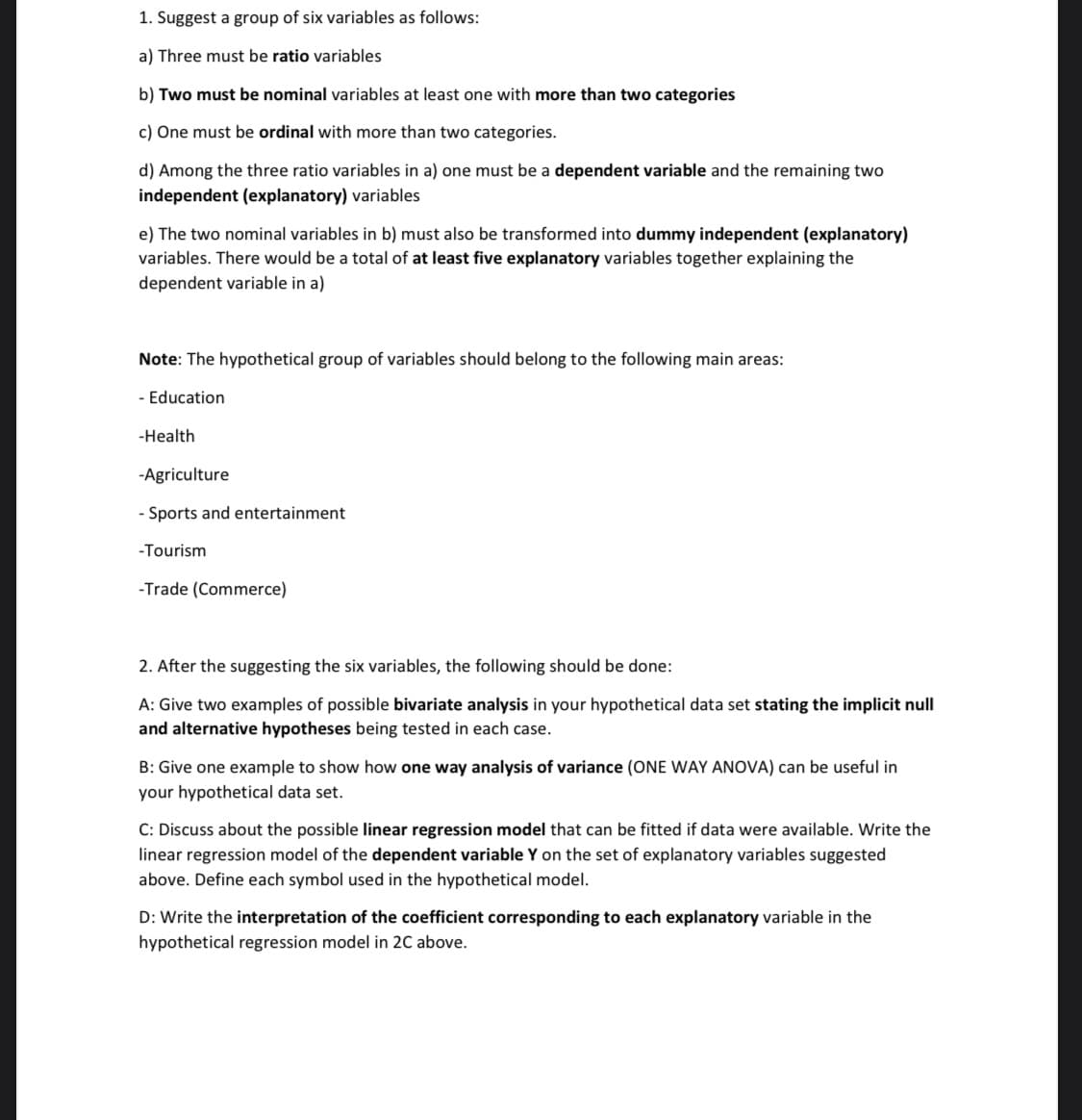1. Suggest a group of six variables as follows: a) Three must be ratio variables b) Two must be nominal variables at least one with more than two categories c) One must be ordinal with more than two categories. d) Among the three ratio variables in a) one must be a dependent variable and the remaining two independent (explanatory) variables e) The two nominal variables in b) must also be transformed into dummy independent (explanatory) variables. There would be a total of at least five explanatory variables together explaining the dependent variable in a) Note: The hypothetical group of variables should belong to the following main areas: - Education
1. Suggest a group of six variables as follows: a) Three must be ratio variables b) Two must be nominal variables at least one with more than two categories c) One must be ordinal with more than two categories. d) Among the three ratio variables in a) one must be a dependent variable and the remaining two independent (explanatory) variables e) The two nominal variables in b) must also be transformed into dummy independent (explanatory) variables. There would be a total of at least five explanatory variables together explaining the dependent variable in a) Note: The hypothetical group of variables should belong to the following main areas: - Education
Elements Of Modern Algebra
8th Edition
ISBN:9781285463230
Author:Gilbert, Linda, Jimmie
Publisher:Gilbert, Linda, Jimmie
Chapter1: Fundamentals
Section1.1: Sets
Problem 37E: Prove or disprove that AB=AC implies B=C.
Related questions
Question

Transcribed Image Text:1. Suggest a group of six variables as follows:
a) Three must be ratio variables
b) Two must be nominal variables at least one with more than two categories
c) One must be ordinal with more than two categories.
d) Among the three ratio variables in a) one must be a dependent variable and the remaining two
independent (explanatory) variables
e) The two nominal variables in b) must also be transformed into dummy independent (explanatory)
variables. There would be a total of at least five explanatory variables together explaining the
dependent variable in a)
Note: The hypothetical group of variables should belong to the following main areas:
- Education
-Health
-Agriculture
- Sports and entertainment
-Tourism
-Trade (Commerce)
2. After the suggesting the six variables, the following should be done:
A: Give two examples of possible bivariate analysis in your hypothetical data set stating the implicit null
and alternative hypotheses being tested in each case.
B: Give one example to show how one way analysis of variance (ONE WAY ANOVA) can be useful in
your hypothetical data set.
C: Discuss about the possible linear regression model that can be fitted if data were available. Write the
linear regression model of the dependent variable Y on the set of explanatory variables suggested
above. Define each symbol used in the hypothetical model.
D: Write the interpretation of the coefficient corresponding to each explanatory variable in the
hypothetical regression model in 2C above.
Expert Solution
This question has been solved!
Explore an expertly crafted, step-by-step solution for a thorough understanding of key concepts.
Step by step
Solved in 3 steps

Recommended textbooks for you

Elements Of Modern Algebra
Algebra
ISBN:
9781285463230
Author:
Gilbert, Linda, Jimmie
Publisher:
Cengage Learning,

Elements Of Modern Algebra
Algebra
ISBN:
9781285463230
Author:
Gilbert, Linda, Jimmie
Publisher:
Cengage Learning,